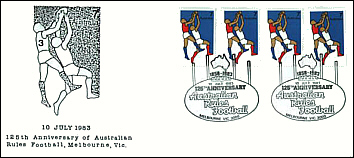|
|
|
Early History |
Origins of the
Game
Football was first played in Melbourne,
Victoria, perhaps as early as 1840 although there was probably little
resemblance to the game that is played today. The origin of Australian Football
has long been in dispute. One theory is that it originates from an Aboriginal
game, Marngrook (Gunditjmara for game of the ball), in which a opossum
or kangaroo skin was kicked around, a noted feature being the high marking.
Proponents of this theory suggest this is why many Aboriginal players of today
show such exceptional skill. A popular theory of recent years was that the game
was borrowed from Gaelic Football although Professor Geoffrey Blainey, a noted
Australian Historian and previous Professor of Australian Studies at Harvard
University, disputes this, as Gaelic Football as played in Ireland is a more
recent game. He purports that Australian Football developed essentially as an
Australian invention although it borrowed extensively from English football
games particularly from rugby. |

|
This private cover demonstrates
one of the most spectacular and distinctive features of Australian Football
namely the high marking. The stamps displayed are the first issued to feature
Australian Football. They were part of the Non-Olympic Sports issue of 24th July
1974. The cover is cancelled using the 125th Anniversary Commemorative Postmark.
(PM 1050)
The origin of the word mark is interesting.
One theory suggests it comes from the player marking the spot on the ground
after catching the ball. The other relates to the aboriginal word mumarki
meaning to catch. |
 |
The 1858
Season
On the 10th July 1858 Tom
Wills, a noted Melbourne Cricketer, wrote a letter to the new
sporting weekly, Bell's Life in Victoria, suggesting that a football
club be formed so as to keep crickets fit during the winter.
The
125th anniversary of the publication of
this letter was commemorated in 1983 by Australia Post by release of a
commemorative postmark. (PM 1050) Shown above
Following the publication of Will's letter, an
astute publican offered a football for practice just north of the cricket
ground. The resulting match on the 31st July was chaos due to the non existence
of standard rules. A similar outcome resulted from a match between Melbourne
Grammar School and a group of men calling themselves the St. Kilda club.
The next week Melbourne Grammar turned to Scotch
College for a game. This famous match, which is represented by a plaque on the
wall of the Melbourne Cricket Ground, claimed incorrectly to be the first
Australian Rules game. It took place over three weekends on the 7th and 21st
August and 4th September and ended in a draw, one goal each. |

|
The Early
Years
Prior to the commencement of the 1859
season saw the first known rules being formulated and put to paper, following a
meeting probably chaired by Tom Wills. this makes Australian Football one of the
oldest football games in the world. Season 1860 saw the permanent use of oval
balls. Prior to this both round and oval balls were used depending on their
availability. Rules changed and were revised regularly. 1872 saw the
introduction of the umpire throwing the ball in the air in the event of a
scrimmage. In 1874 it was decided that goals must be kicked and not decided by
scrum. In 1880 umpires began to wear white and in 1886 the waving of flags to
signify goals was introduced. 1891 saw the bouncing of the ball in the middle
after a goal was kicked.
The 7th May 1877 saw the formation of the
Victorian Football Association (VFA). The foundation clubs were metropolitan
teams Albert Park (later South Melbourne), Carlton, Hotham (later North
Melbourne), Melbourne and St Kilda, adjacent teams of Geelong and Barwon and
country teams of Inglewood, Ballarat, Beechworth, Castlemaine and Rochester. The
VFA oversaw revision of the rules and the playing of inter-colonial games. The
game flourished in Tasmania, South Australia, Western Australia and even
for a time in New Zealand. Unfortunately the VFA and others failed in New South
Wales and England. Dissatisfaction with rules and the running of the competition
led to the formation of the breakaway Victorian Football League (VFL) at a
meeting on the 3rd October 1896. |
|
|
|
|